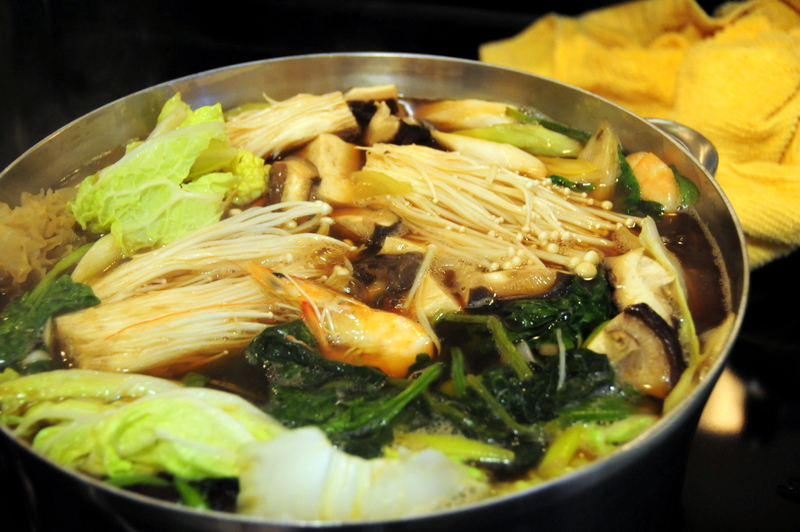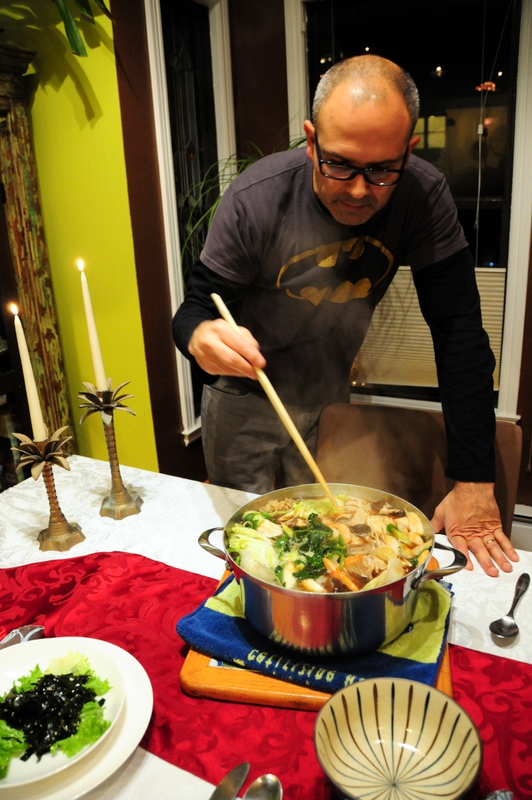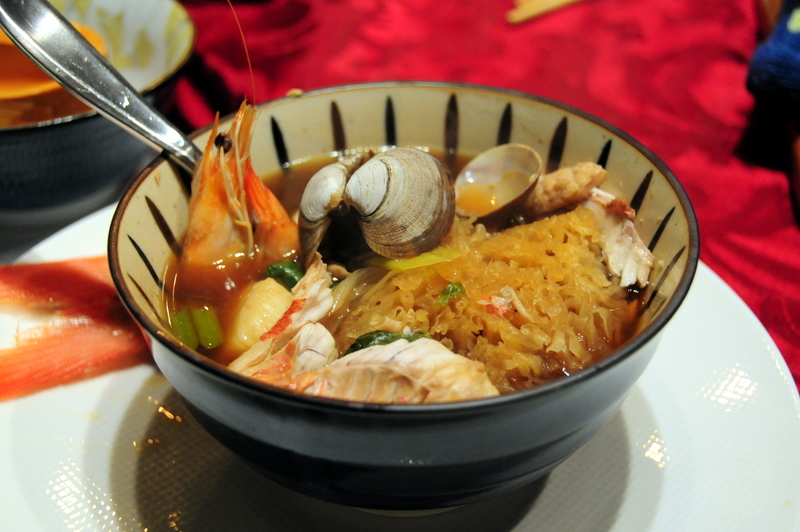Nabe (sometimes called nabemono) is a brothy soup made with a hodgepodge of vegetables, seafood and meat that is prepared with all of the aforementioned items combined into endless “weirdcombinations.” If you have not tried classic nabes such as Oden, Sukiaki, Shabu-Shabu or Chanko Nabe you are definitely missing out! They are all delicious and perfect for the kind of weather that we’ve been having across the U.S. lately, and in the case of San Francisco, the chilly City by the Bay, I would say anytime of the year.
My neighbor in Brazil, Aidê, is married to a lovely man, Shibahara, who happens to be a native of Japan. From time to time the couple would invite my sister, Tinha, and I for beautiful Japanese inspired dinners at their place. It was such a treat! Aidê took some Japanese cooking classes when she lived there and she became quite accomplished. Her sukiakis were incredible.
I really enjoy this kind of soup: a relatively clear but aromatic broth with lots of exciting things to discover under the surface. I’ve tried my hand at Thai Tom-Yum, and South Indian Rasam. Nabe is superficially similar to these yet completely different in taste and flavor. Perhaps sometime soon I’ll try to make a vegetarian version of a traditional French consomé.
Another thing that all these soup recipes have in common is that they’re relatively labor-intensive, what with all the ingredients and the importance of making a clear broth with a subtle yet distinctly memorable flavor. Nevertheless, you will not be disappointed when you sit down to this hearty delightful dish.
I made this in homage to my friend, Aidê. The recipe itself is adapted from rasamalaysia.
Look here for more about nabe.
seafood vegetable nabe
for Dashi broth:
12 cups water
1 12inch piece of kombu (dried kelp)
1 cup dried smoked bonito flakes
for seafood vegetable nabe:
8 cups dashi broth
1 cup mirin
4 tbsp sake
1 cup shoyu (soy sauce)
8 leaves of Napa cabbage
12 manila clams
4 head-on shrimp
4 sea scallops
1 whole red snapper (about 1½ lbs), cleaned and cut into a few chunks
a small bunch spinach
4 fresh shiitake mushrooms
1 small package fresh enoki mushrooms
1 re-hydrated tremella mushroom quartered (learn more here)
1 lb firm tofu, drained and cubed
1 small carrot, peeled and cut into thin pieces
2 giant Japanese scallions (negi)
1 tbsp butter
Kosher salt
shichimi togarashi (Japanese chili pepper mix)
to prepare Dashi broth:
Place water in a large pot. Add kelp, cover and let it re-hydrate for two hours. Move pot to stove. Bring temperature to high and cook kelp for one minute after water reaches boiling stage. Discard kelp. Turn temperature to low. Add ½ cup of cold water to bring temperature down a bit. Add bonito flakes to broth and simmer for a couple of minutes. When the flakes sink to the bottom of the pan, it is time to remove them. Place a large strainer over a large bowl. Cover with a clean kitchen towel. Pour broth through towel and strainer. Discard bonito flakes.
I had some leftover broth, which I froze to make another kind of soup later. I’m thinking soba noodle.
to prepare nabe:
Combine dashi, mirin, shoyu and sake in a large pot or bowl. This is the broth for the nabe. Using another large pot, lay Napa cabbage leaves at the bottom. Interchangeably arrange vegetables and red snapper in the pot. Pour broth over stacked fish and vegetables. Cover and bring to boil. Taste broth and if necessary adjust flavors with more shoyu or salt. Add shrimp, clams, scallops and cook long enough for the clams to open. Remove from heat, add butter and serve. Sprinkle some shichimi togarashi on top. This is delicious!
I found this quote about nabemono that really went to the heart of the recipe:
Eating together from a shared pot is considered as an important feature of nabemono; East Asian people believe that eating from one pot makes for closer relationships. The Japanese thus say, Nabe (w)o kakomu (鍋を囲む、”sitting around the pot”), implying that sharing nabemono will create warm relations between the diners who eat together from the shared pot.
We shared this soup with our friend, Juanita. It warmed our bellies, and since our friendship is already warm, I guess then it made it warmer still!



Comments on this entry are closed.
Oh I LOVE Shabu Shabu. And this seafood nabe look delicious! It’s similar to how we eat hotpot, or steamboat as we sometimes call it. In Hong Kong, they have their own bowls of sauce to eat with the meat/veg, which I thought was an interesting way to eat. You choose what you want like minced garlic, cilantro, chilli oil, oyster sauce, sesame oil etc etc and the traditional way includes mixing a raw egg into it, which I don’t like so much. And I guess eating from one pot brings does people closer together in a way but I can’t really explain why. It’s just such a different atmosphere and anything goes.
Hi Sharon,
happy Friday!
Yes that’s the idea. We love these types of soup with clear flavorful broth. This was a Japanese take on hotpot. I didn’t know in Hong Kong there is a similar dish that goes by the name steamboat. It’s always great to learn something new! I am with you when it comes to having a raw egg over the soup. Although at imes we go to a Korean restaurant nearby us where they serve a tofu soup flavored with kimchi whereupon a raw egg is mixed into the hot broth just before serving. I remember I enjoyed eating it!
H
This is a lovely custom; similar to the Arab and African customs of eating from communal plates with pita as a utensil. I love it! I can see I need to familiarize myself with Asian ingredients. The soup looks fabulous and definitely worth the effort. Cheers!
What a great tribute to your friend. I’ve never tried nabe before, but now I know that I must! I love the quote you included about the concept behind using a shared pot. This would be such a great dish to prepare for a dinner party. Thank you for sharing. I hope you have a weekend full of laughter with those that you love.
Hi Stevie- thanks for stopping y my blog so that I could discover yours! The nabe looks delicious and that shot of your bowl is lovely!